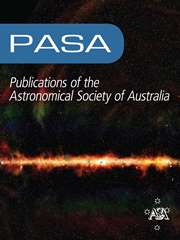No CrossRef data available.
Article contents
A Main Sequence CH-star in the globular cluster M55 (NGC 6809)
Published online by Cambridge University Press: 07 April 2025
Abstract
Spectra have been obtained with multi-fibre instrument 2dF on the Anglo-Australian Telescope of 89 candidate main sequence stars in the globular cluster M55 (NGC 6809). Radial velocities and Gaia proper motions confirm 72 candidates as cluster members. Among these stars one stands out as having a substantially stronger G-band (CH) than the rest of the member sample. The star is a dwarf carbon star that most likely acquired the high carbon abundance ([C/Fe] ≈ 1.2 ± 0.2) via mass transfer from a ∼1–3 M⊙ binary companion (now a white dwarf) during its AGB phase of evolution. Interestingly, M55 also contains a CH-star that lies on the cluster red giant branch – the low central concentration/low density of this cluster presumably allows the survival of binaries that would otherwise be disrupted in denser systems. The existence of carbon stars in six other globular clusters is consistent with this hypothesis, while the origin of the carbon-enhanced star in M15 (NGC 7078) is attributed to a merger process similar to that proposed for the origin of the carbon-rich R stars.
- Type
- Research Article
- Information
- Creative Commons
- This is an Open Access article, distributed under the terms of the Creative Commons Attribution licence (https://creativecommons.org/licenses/by/4.0/), which permits unrestricted re-use, distribution and reproduction, provided the original article is properly cited.
- Copyright
- © The Author(s), 2025. Published by Cambridge University Press on behalf of Astronomical Society of Australia


